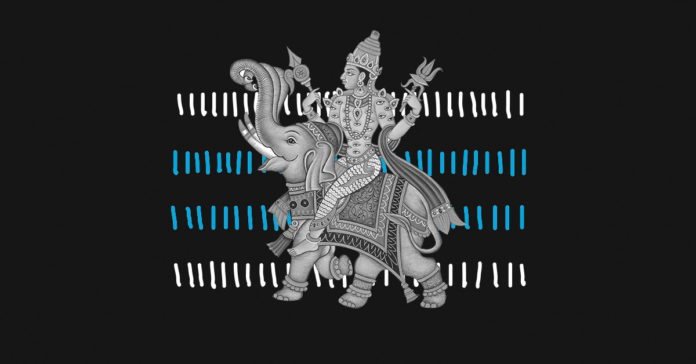Lack of Absolute Power
Hindu gods and goddesses not only lack in absolute power but often appear to project weakness. The scriptures are full of references to wars between gods and asuras (demons). Hindu sages sometime appear to be mightier than the gods. The gods were afraid of the penances exercised by the sages who could topple them with these exercises. The usual method the gods adopted to distract the attention of the rishis (sages) engaged in penances was to lure them into sexual temptation. On occasions gods sought the intervention of the rishis in their disputes with one another.[1] The case of Siva, for instance, indicates how helpless he was before the sages. Hindus worship not him but his linga (sex organ). According to the Padma Purana, this is because of a curse by a saint called, Bhrigu, that he ceased to be worshipped in the form of human being and his linga became an object of worship. According to the Vamana Purana, it was the result of a curse pronounced by a number of sages.[2]
The story of Rama narrated in the Ramayana, portrayed that a monkey, called Hanumana, was much more powerful than him. When he along with his wife Sita and his step-brother Lakshmana was in exile in the forest, Sita was kidnapped by Ravana, king of Lanka. Rama could not even locate her. It was Hanumana who could find her with Ravana, helped Rama to cross over to Lanka, defeat Ravana in a fight and rescue Sita.[3] Once Lakshmana was hit by a poisonous arrow. His wound could be healed with a medicinal herbs available in the Oshadhi Mountain in the Himalayas. Rama could not collect the medicinal herb; so he sought the help of Hanumana. The monkey went to the mountain to bring the herb but could not identify it. So he lifted the whole mountain and carried it to Lanka.[4] Proving his great power, the monkey himself became a god.
Doctrine of Avatara
Hindus believe in innumerable avatars (incarnations) of gods and they can add to their number without any difficulty. An incarnation appears in the form of a creature, which may be a man, an animal or both. He comes to this world to destroy a particular evil or injustice and to restore order. Vishnu is commonly believed to incarnate ten times. Of his ten incarnations, nine have already appeared. Among them are Rama and Krishna. Gautama Buddha, the founder of Buddhism, is the ninth incarnation of Vishnu. Although his religion was different from Hinduism, the Brahmans made him an avatara so as to bring the Buddhist community under the fold of Hinduism. The last incarnation named Kalki is yet to appear. He will be a man riding upon a white horse with a sword in his hand. He will purify the Kali Yuga (Kali age) and restore purity and goodness. Some Hindu scholars, however, suggest that ‘avatara’ in Sanskrit is used in the sense of prophet in English. As the descriptions given in Hindu scriptures about Kalki resemble those of Prophet Muhammad (pbuh) these scholars believe that Muhammad (pbuh) was the last among the avatars?[5]
Substitution
In the history of Hindu gods, one finds that some gods have been worshipped for a time and then abandoned. Thereafter quite new gods are created and worshipped with devotion. Again, these new gods are abandoned and replaced by a fresh set of gods. For instance, Hindus replaced the gods who were worshipped in the Vedic age by those to whose praise the Puranas are devoted. Shiva, Vishnu, Rama and Krishna who are worshipped by Hindus now-a-days attained prominence at a much later stage. Among the Vedic gods who lost their importance were Mitra, Varuna, Rudra, Indra, Agni, Prajapathi and Savidar. Finally, the trinity of Brahma, Vishnu and Siva replaced the rest. Brahma, later, lost his importance, leaving Shiva and Vishnu as the two important deities, along with the other popular gods and goddesses such as Parvati, Ganesa, Skanda, Krishna, Lakshmi, Hanumana, Ganapathi and others.
Family Life
Hindu gods and goddesses were born like human beings and had married lives with spouses and children. For instance, Yama, god of spirits, was born of Vivasvat (the sun) and Saranya. Saraswati, goddess of learning, was a daughter of Brahma. Lakshmi, goddess of good luck, was born of Bhrighu and Khyati. She was married to Vishnu. Indra, the deity of storm, was married to Indrani. Once having won victory over some demons, Durga, wife of Siva and herself a goddess, danced for joy so furiously that the earth trembled beneath her weight. Being afraid that the earth would be destroyed, Siva asked her to stop but she did not. In a bid to make her stop, Siva lay down among the slain. Durga continued dancing until she found that her husband was under her feet. She immediately thrust out her tongue with shame at the disrespect she had shown to him.[6] Once when she was hungry, Durga asked Siva to give her some food. But when she found that Siva was late in giving her food, she swallowed him. Immediately her body started emitting dhum (smoke). Since then she got the name Dhumabathi.[7]
Variety of Images
Hindu gods and goddesses are described in many qeer ways, possibly, to make them attractive to the people. In the words of S.D. Theertha, “Gods and goddesses are described in numerous fantastic forms with many heads and hands, in the shape of animals and semi-human beings, sleeping on snakes and riding on rats, possessing wives and children, some of whom sit on the heads of their lord, and doing things which decent men should shun, pictures which now furnish models for advertisements of beer or cigarettes and stories which disfigure the nation’s life.”[8] In pictures, Vishnu is represented as a black man, with four arms; in one hand he holds a club; in another a shell; in a third a chakra (discus), with which he slew his enemies; and in the fourth a lotus. He rides upon the bird Garuda, and is dressed in yellow robes. Siva is represented as having a third eye in the middle of his forehead. Durga has ten arms, in one she holds a spear, with another a tail of a serpent, with still another the hair of a giant whose breast the snake is biting. Her other hands are filled with various arms.[9] Ganesa, son of Siva and Durga (regarded as the god of wisdom), has as his head that of an elephant. Ugrachanda has eighteen arms. Chinnamastha has her head in her left hand after separating it from her own body. Jagaddhathri has four hands, three eyes, and is seated on a lion. Jhar has three heads, nine eyes, six hands and three legs.[10]
Representation
In Hinduism, even ordinary things can represent gods and goddesses for the purpose of worshipping. This fact may be illustrated by the following examples:
Vishnu. Vishnu is represented by salgrama (a kind of rock). When his wife discovered that he had affair with another woman, she cursed that woman. As a result of her curse, that woman was changed into a plant, called tulasi. Vishnu, in order that he might still enjoy the company of his beloved (now a plant, tulasi), transformed himself into a salgrama. Thus salgrama became a representative of Vishnu.
Siva. Siva is represented by the linga (sex organ) which is an upright pillar of stone erected in the temples dedicated to him. The image is daily bathed with water, milk and bhang, and large quantities of food are placed before it. Flowers, sandalwood, and clothes are also presented.
Lakshmi. Lakshmi is the goddess of good luck. No image is made for her worship. Her representative is found in every house. That is a basket for measuring corn.
Sasthi. Sasthi is the protectress of women and children. The banyan tree, being specially sacred to her, is her representative.
Manasa. Manasa is the queen of snakes. An image is made for worshipping her but a pot of water represents her for this purpose.
Non-Forgiving
Hindu gods show no sign of love or goodness. The idea of a ‘god of love and goodness, who is ready, without solicitations, to do good is unknown in Hinduism. He is regarded rather as an enemy whose favour must be purchased, a judge whose decisions can be influenced by gifts and service. Further, it is a common and widespread notion that a man by doing any extraordinary deed, such as the setting up of an image in his house for worship, visiting a shrine, bathing at a specially holy place, making a pilgrimage, incurring bodily suffering, can have these good deeds written to his credit as an equivalent for a certain sin. Though there are manifold ways prescribed for getting rid of sin, it is explicitly declared in the Hindu shastras that pardon is impossible. As a man works so will be his reward. But if there is no pardon, no forgiveness on God’s part, there is the payment of an equivalent on theirs.’ For a Hindu, therefore, there is no prayer for the pardon from sins.[11]
Immoral and Criminal Activities
Hindu gods freely indulge in immoral and criminal activities. Their incarnates also indulge in such activities. Brahma cohabited with his own daughter, Saraswati, for one hundred years. For this crime, he ceased to be worshipped. In the Skanda Purana, a charge of falsehood is proved against him. This fact also has been mentioned as a reason for his being deprived of adoration.[12] Vishnu deceitfully had intercourse with Shankhachur’s wife, Tulasi. He could ruin her chastity because he had assumed the form of her husband.[13] Later, he continued his illicit sexual relations with her.[14] According to Brahmabaibartha Purana, when Tulasi discovered that Vishnu had destroyed her chastity deceitfully, she cursed him. As a result of that, he became salgrama, a rock found on the bed of the river Gandaki to the south of the Himalayas.[15] Indra, a Vedic god, seduced Ahallya, wife of his teacher Gautama.[16] He also stole king Sagar’s horse. Rama murdered Vali, who did not do anything wrong to him, in the most odious way. He also killed Sambuka, an innocent man when he was performing rigorous tapasya (penance). He sent his pregnant and innocent wife, Sita in exile, in the most cruel manner. Krishna had a career full of intimacy with so many young women. His illicit relation with Radha, wife of his maternal uncle, is a well-known fact.
[Hinduism and Islam: A Comparative Study by Murtahin Billah Fazlie, p. 77-85]
Notes:
[1] Dr. Sajjad Husain, A Young Muslim’s Guide to Religions in the World, (Dhaka :1992), p. 98.
[2] Wilkins, 1993, pp.280-81.
[3] For details, see Ambedkar.
[4] Shakunthala Jagannthan, Hinduism An Introducrion (Bombay: 1991), pp. 14-15.
[5] For details see Kalki Avatar Abong Muhammad Saheb (Bengali) by Dr. Veda Prakash Upaddhay, Research Scholar, Department of Sanskrit, Prayag University, India.
[6] Wilkins, 1993, p.309.
[7] Bhattachariya, op. cit., p. 57.
[8] Theertha, pp.118-19.
[9] Wilkins, 1993, pages, 120-21, 270, 300.
[10] Bhattacharya, op. cit., p. 51-55.
[11] Wilkins, 1975, pp. 41-42.
[12] Wilkins, 1993, pages 100-01, 106.
[13] Sarkar, p. 199.
[14] Wilkins, 1975, pp. 52-53.
[15] Sarkar, p.504.
[16] Wilkins, 1993, pp. 60-61.









